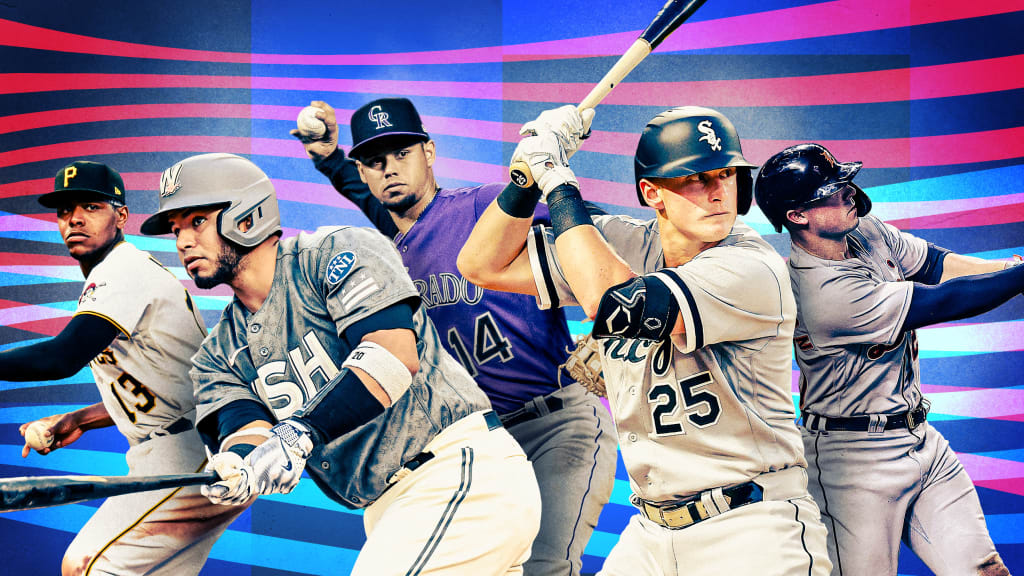
In the immediate aftermath of the MLB Trade Deadline, most of the attention gravitates toward the aggressive buying teams and key players who moved to playoff contenders. Intuitively, that makes sense as we watch players make impacts on new teams in their postseason runs.
On the flip side, you have the sellers, the struggling teams who make a conscious effort to sacrifice short-term value in exchange for long-term gain. Even then, most of the discussion centers more on the new players or prospects heading to the sellers and less on the players who were already there in the first place.
It's those players in place who are often overlooked as the potential catalysts that can shape the future of an organization. Below, you'll find a list of the most important players on the obvious sellers, whose remaining games this season are still vital for both the player and team alike.
With that in mind, here are the nine key players on selling teams to watch out for the rest of the season. All stats are through Thursday's games.
Spencer Torkelson, Tigers
The Tigers are engulfed in a postseason drought that extends back to 2014, tied with the Angels for the longest in the Majors. A main culprit of that drought has been the stalled development of some of their top prospects like Torkelson. The 2020 No. 1 overall pick has played below his lofty expectations in his first two seasons in the big leagues. In 220 games, the Tigers' first baseman has a .214/.295/.365 line and a wRC+ that is 13% below the league average.
The good news for the Tigers and Torkelson is there have been signs of hope in '23 despite the subpar surface stats. His .345 expected wOBA -- based on the quality of contact (exit velocity, launch angle), strikeouts and walks -- is well above his actual .307 wOBA. Torkelson is consistently crushing baseballs and ranks in the 80th percentile or better in barrel rate, average exit velocity and hard-hit rate. If Torkelson can turn those underlying numbers into actual production, the Tigers will be in much better shape heading into 2024.
Matthew Liberatore, Cardinals
Similarly to the Mets, the Cardinals entered the season as likely playoff contenders and ended up selling at the Deadline. For the first time since 2007, St. Louis is a certain bet to finish below .500. One of the obvious issues plaguing the Cardinals is the discrepancy between their talented group of position players and a largely ineffective group of pitchers. While the upper levels of the Minors are littered with talented pitching prospects, they'll need someone like Liberatore to take a step forward in the coming years.
The 23-year-old lefty is probably better known for being the key part of the return that sent Randy Arozarena to the Rays. However, Liberatore had a positive development on Thursday in his first start against his former team in St. Petersburg. Heading into that start, he had a 6.47 ERA with 51 strikeouts and 36 walks in his first 72 1/3 innings as a big leaguer. After not pitching more than six innings in any MLB outing, Liberatore stifled Rays hitters in eight scoreless innings with a career-high seven strikeouts. If Liberatore can build on this for the rest of the season, the Cardinals will be in a much better position heading into 2024.
Andrew Vaughn, White Sox
Much like Torkelson, Vaughn is an AL Central first baseman who has underperformed his previous top prospect status after producing a prodigious college baseball career. Following an unsuccessful experiment as an outfielder from 2021-22, Vaughn permanently moved back to his natural first base position in 2023. Unfortunately for Vaughn and the White Sox, the 25-year-old's offensive output still hasn't budged much above a league-average hitter. Through 368 career games, Vaughn's 104 wRC+ and below-average defense have essentially made him a replacement-level player.
Vaughn's issues have been less about a specific glaring issue and more about not having a true standout offensive skill. His approach and quality of contact have basically pegged him as a league-average hitter, which doesn't really work given his defensive limitations. All hope isn't lost for Vaughn, who is still plenty young enough to turn things around in his career. For a White Sox team that is in something of a rebuild now, Vaughn will be given ample opportunity to become the franchise-altering bat the organization thought he could turn into.
David Peterson, Mets
To put it simply, the 2023 Mets experiment did not go according to plan. On the heels of a 101-win season in 2022, things went poorly enough that the Mets were aggressive sellers at the recent Deadline, moving veteran stars Justin Verlander and Max Scherzer. As the Mets look to 2024 and beyond, it's vital that they see one of their internal starting pitchers take a step forward to fill the rotation void.
Peterson and Tylor Megill are both obvious candidates as pitchers who the Mets would like to see take a step forward. It's Peterson, though, who is probably the most important of the two and someone who has had stretches of MLB success. After a strong 2022 season (3.83 ERA and 1.4 WAR), Peterson has seen his numbers take a step back in '23 to the tune of a 5.61 ERA and 4.94 expected ERA. As a 6-foot, 6-inch lefty with the ability to miss bats (68th percentile this year), there's plenty to hope for but he'll need to start limiting the walks and hard contact to get to the next level.
Ke'Bryan Hayes, Pirates
To be perfectly clear, Hayes is probably the best player on this list and someone who is at least a solid regular thanks to his world-class defense. Since 2022, only Dansby Swanson has racked up more Outs Above Average (+35) than Hayes (+30), who is arguably the top third-base defender in the sport. Fantastic as his defense may be, Hayes has seen his offense dip to a level that places him among the least productive hitters in the Majors.
After crushing in a 24-game stint (194 wRC+) as a rookie in 2020, Hayes has posted an 87 wRC+ since '21 -- tied for 19th-lowest among hitters with at least 1,000 plate appearances. Despite the subpar offensive performance, there's hope that Hayes' combination of hard contact and strong bat-to-ball skills leads to better numbers in the long term. Encouragingly, Hayes has rebounded after a poor start to the '23 season -- which included multiple stints on the injured list -- to post a 126 wRC+ and .316 batting average since June 1. If he can even remotely approach a league-average hitter, he's a superstar who can help carry the Pirates.
Keibert Ruiz, Nationals
Washington's rebuild following its 2019 World Series run might not end up lasting too long. Thanks to a collection of performing MLB youngsters such as MacKenzie Gore, Josiah Gray and CJ Abrams and uber prospects like James Wood and Dylan Crews, the Nationals could start turning things around as soon as next season. If their 25-year-old catcher can take a step forward, the future could look even brighter.
Ruiz, along with Gray, was one of the headlining prospects in the mega trade that sent Scherzer and Trea Turner to the Dodgers in 2021. The switch-hitting Ruiz has mostly been fine in the Majors, hitting .252/.311/.381 with a 91 wRC+ across his first 239 games. The larger issue, though, has been his defense behind the plate; the new Fielding Run metrics from Statcast peg Ruiz as the worst defender (-18 runs) in the Majors this year. If he can just hit a little more, which his underlying metrics say he should, might be able to compensate for the defense and get Washington back to competitive baseball.
Brady Singer, Royals
The Royals are sort of caught between a rock and a hard place. Their record is worse than every team outside of the A's while Bobby Witt Jr., who's in the midst of a breakout season, is their only player above 2 WAR. Despite that, the farm system doesn't have a single top 100 prospect according to MLB Pipeline. To head in the right direction, Kansas City will need players such as Singer to take big steps forward.
After a breakout 2022 season (3.23 ERA and 2.9 WAR), Singer's production has backtracked in '23. His 5.05 ERA, which is higher than all but eight starters (min. 100 innings), is essentially backed up by a 4.93 xERA. The main issues for Singer have been losing 1.5 mph of fastball velocity from last year and seeing a drastic decline in his strikeout-to-walk ratios -- his 2.70 K/BB ratio in 2022 is a far cry from his 4.29 ratio last season. The good news: Singer has pitched closer to last year's level in recent starts. After posting a 5.80 ERA in the first half, Singer has a 2.94 ERA in his last five starts, including a recent scoreless eight-inning outing against the Mets.
Ezequiel Tovar, Rockies
It's perhaps unfair to place this kind of expectation on a 22-year-old with just 117 MLB games under his belt but that's where the Rockies currently stand. It's not a roster that has much in the way of potential impact players beyond Ryan McMahon, who leads the team with 1.7 WAR. Tovar is pretty clearly the most talented youngster in Colorado, a shortstop with similarly outstanding defense as the aforementioned Hayes.
On the basis of his defense alone, Tovar can make it work as an MLB regular. In 108 games this year, he's racked up 1.4 WAR thanks to his 7 Outs Above Average, tied for the seventh-most among shortstops. His offense, however, is far behind his stellar defense -- only three players (minimum 400 plate appearances) have a lower wRC+ than Tovar (75). It's a tough offensive profile when you swing as much as Tovar does without the high quality of contact to go with it. If Tovar can get anywhere close to the .782 OPS he posted in the Minors, he has an outside shot at being a star.
Shea Langeliers, A's
Things are not going well for an A's team that is on pace for just 46 wins, the fewest in a full season since the Tigers won 43 games in 2003. It's an organization that's in need of impact players both at the MLB level and in the upper levels of the Minors. Perhaps no player will garner more attention or expectations than Langeliers, who was the centerpiece in the Matt Olson trade. As Olson inches closer to a 50-HR season, it only feels like Langeliers will increasingly have more of the spotlight on him.
Langeliers certainly has some strengths in his game. He routinely hits baseball hard (career 10.5% barrel rate) and he's thrown out more runners (26) than any catcher this season. His issues stem from a poor approach at the plate -- he ranks in the bottom-25th percentile in whiff and chase rate -- which has led to a career .263 OBP. Getting on base that infrequently makes it hard to stick as a regular, even if you're a catcher with a strong arm and pop. If that OBP can get closer to .300, his value will skyrocket as a potential impact regular for the A's.
